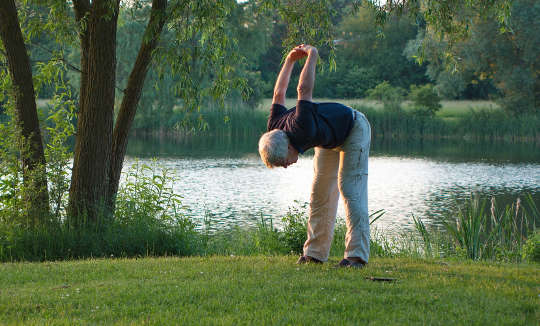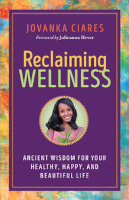
Image by Christian Northe
Wellness is not for the privileged few. Wellness is a state of living that applies to all living creatures — humans, animals, and plants. And the most popular wellness practices have been practiced for millennia by people all over the world. Wellness is a way of life that emerges from and is for all of us.
This includes things like the growing popularity of a plant-based diet, meditation, and using saunas and hot springs to improve health. In fact, many modern wellness practices were first embraced by the poorest members of society before they were embraced by the elite. Thanks to these people, their discoveries, and their passion to pass on what they learned to each generation, we enjoy and benefit from these practices today.
What Is Wellness?
To me, wellness is an inclusive term that describes an individual’s overall health and covers all aspects of one’s being — body, mind, and spirit. Working to attain a state of wellness involves long-term changes to our entire lifestyle, not just focusing on only one aspect of life. The goal is to enhance your entire self, including your emotional, physical, mental, spiritual, social, and environmental well-being.
For instance, let’s say someone wants to lose twenty pounds. Achieving that specific physical goal in a lasting, holistic way would include learning which foods nourish their particular body best. They would explore how different foods interact with one another as they travel through the body, impacting digestion, energy, and long-term health. They would also learn about how the foods they enjoy are made and produced, making decisions based on the true environmental and social cost in terms of the resources, land, energy, and people needed to grow and produce the food. With this knowledge, the person will lose twenty pounds, for sure, while gaining the wisdom to make healthier, more responsible choices that improve their life in many mutually supportive ways.
Get The Latest By Email
Many years ago, my journey through wellness began in a similar way. I was almost twenty-five years old and had just moved to New York City, and I was eager to embrace all the amazing experiences that my new life had to offer. I was fit, flexible, and super cute. To others, I must have seemed the picture of health. But I was in pain almost daily.
Like most college students, my finances were very limited, and I didn’t pay much attention to what I ate. Most days, I survived on dried cereal for breakfast, a fast-food combo meal for lunch, and a chocolate candy bar for dinner. As you can imagine, this food provided no nutrients to support my body, and I had no knowledge of the consequences of such a dangerous diet.
Despite my high-sugar, highly processed diet, I was so undernourished and stressed out that I ended up losing fifteen pounds — which I didn’t have to lose — and I had regular digestive symptoms, from constipation and diarrhea to gas and bloating. These were so severe I would topple over and writhe in pain almost every night.
Eventually, my health issues “smacked” me into changing my behaviors. I made the decision to learn how to cook, and I developed a weekly routine of grocery shopping. Even though I grew up in a family that embraced home-cooked meals daily, and my mom and grandma taught me basic cooking skills, I hadn’t bothered to cook or shop on my own until that moment.
The process of learning how to make different dishes taught me valuable lessons about nourishing and honoring my body as the amazing machine that it is. This wonderful, imperfect body allows me to live, thrive, feel, ache, care, and love, and it deserves to be cared for the best way I know how. I am immensely grateful that I had youth and time on my side as I embarked on this journey of learning how to do that.
I did not have a life-threatening disease, and I could make lifestyle changes relatively easily. But no matter what our personal circumstances, we are never powerless. There is so much we can do to support our body and restore balance and a sense of peace, to get as close to homeostasis — or a state of health and well-being — as possible.
Without knowledge, we can be at the mercy of others — like advertisers and wellness gurus — who want our business and have their own agendas. Some would have us believe that only certain brands or expensive programs can foster wellness. Instead, I encourage you to explore and to question, to increase your knowledge and to trust yourself, as you evaluate what practices might be best for you and which might be inappropriate, unhelpful, or even dangerous. Be curious about what could lead to a healthier, stronger, happier version of you, and pursue that curiosity to create just that.
The Big Picture: Wellness Is Holistic
Wellness is for everyone: young and old, sick and healthy, rich and poor, and all races and ethnicities. Wellness also includes everything, or all aspects of our lives, and the ultimate goal is to achieve positive, sustainable, long-lasting changes. Wellness is not a single thing we do, it doesn’t happen all at once, and our wellness practices should increase happiness, not feel like a chore.
Ideally, wellness is how we unlock and access the full potential liying within. This isn’t about following lifestyle rules to a T, but rather understanding our choices and owning them. We will certainly encounter roadblocks during this process, and that’s to be expected! Pursuing wellness with an “all-or-nothing” attitude is a nonstop ticket to frustration and failure. Instead, if we accept ourselves, and trust the natural process, things will slowly fall into place.
Wellness is about creating balance and strengthening the connection between our physical, mental, and spiritual selves. As a result, what we do to achieve wellness will vary depending on what needs more attention at any particular time. For instance, if our spiritual life is strong but our physical activity isn’t, then we might find balance by focusing more on our physical self, while continuing to strengthen all the other parts that make us who we are.
In the big picture, wellness is about being at peace in and with the world. We are each an integral part of the whole that we call the universe. The energy that emanates from each of us, as well as from plants and animals, is interconnected. Our daily choices touch millions of lives, whether we realize it or not. Being aware of this interconnectedness fosters a holistic awareness of our place in the world and helps us make positive, conscious choices every day in our lives.
Seven Wellness Concepts
As a certified wellness coach and lecturer, I’ve identified seven wellness concepts or areas that are the most popular or impactful in the modern wellness industry. Curiously, these seven concepts all have one thing in common: They were originally created, developed, used, taught, and shared by a deeply diverse group of people from around the world.
In my experience, these seven are also the easiest to implement regardless of someone’s socioeconomic background or access to resources. Yes, people can spend thousands of dollars and lots of time pursuing each one, but none require expensive investments of time or money. Most are free, and all can be incorporated into anyone’s existing daily routine.
Here are the seven practices:
1. Plants That Help Us Heal
The use of plants as traditional medicine is widespread in history, though cultural traditions vary and have different names. They include Ayurveda (India), traditional Chinese medicine (China), Kampo (Japan), shamanism (South America), and Western herbalism (Europe and North America).
Every group of people around the world has benefited from the use of plants to address ailments and help the body heal. In today’s world, the use of botanicals and other plants as supplements has become a multibillion-dollar industry, but I promise you, you don’t need a ton of money to use them.
2. Going Within
Meditation, mindfulness, visualization, and contemplative practices help us connect our physical and emotional sides. These practices don’t require any spiritual beliefs, and they aren’t meant to replace someone’s religion. They are like “mental workouts” that calm our bodies and our minds and instill peace. We can use them effectively to enrich our understanding of what is sacred and miraculous within.
3. Yoga and Other Forms of Movement
Movement is an integral part of wellness. While there are a number of movement-related practices, and all are helpful, I focus mostly on learning, using, and reclaiming yoga, as its popularity and benefits deserve special attention. In addition, yoga is now embraced by all regardless of age, health, or circumstance.
4. A Plant-Based Diet
Some wellness experts like to say, and with good reason, that improving our health is “80 percent about nutrition, 20 percent about everything else.” Just like how putting crappy oil in a luxury car can reduce the car’s performance and longevity, what we feed our bodies can impact our ability to stay healthy and to heal after illness.
Modern data supports the dietary practices of our ancestors, which emphasized a whole-food, plant-based diet. This doesn’t mean becoming a full-on vegan (unless you’re ready), but it does mean adjusting the balance of our diet to include more health-promoting plants and less meat and processed foods. As the ancients understood, our wellness depends on what we eat
5. Oil, Water, and Heat
For centuries, people around the world have used some combination of water, oil, and heat to help foster wellness — from saunas, steam baths, and sweat lodges to hot oil and Swedish massage. These are, to me, some of the funnest wellness practices because they not only promote healing but restore our mind and soul as well. Many cultures around the world have used these basic ingredients to promote wellness, and you can embrace them, too.
6. Music and Community
Social wellness is a vital part of achieving a state of well-being. And what better way to engage in a loving way with our community than with sound and music? Cultures around the world have long used sound and music as an integral part of the healing process. Meanwhile, all types of community contribute to wellness. Community is a critical ingredient without which we can never be whole and well.
7. Grounding and Nature
“Remember you are dust, and to dust you shall return.” The concept behind this popular biblical quote (from Genesis 3:19) predates the Bible, and it is corroborated by modern science. We are part of the earth and the earth is part of us. Embracing practices that help us reconnect with nature and that protect and honor Mother Earth can help improve our health.
The seventh wellness practice reminds us that we are not far removed from our ancestors and that we are an integral part of all life. By fostering, in simple ways, our connection to nature, we reclaim our rightful state of wellness.
Copyright ©2022 by Jovanka Ciares.
Printed with permission from New World Library
Article Source:
BOOK: Reclaiming Wellness
Reclaiming Wellness: Ancient Wisdom for Your Healthy, Happy, and Beautiful Life
by Jovanka Ciares. Reclaiming Wellness explores today’s most effective wellness practices — and their multicultural sources — in a way that makes overall health accessible to all. If you’ve ever felt left out of “elite” healthcare regimes or thought that being healthy shouldn’t be expensive, this book is for you.
Reclaiming Wellness explores today’s most effective wellness practices — and their multicultural sources — in a way that makes overall health accessible to all. If you’ve ever felt left out of “elite” healthcare regimes or thought that being healthy shouldn’t be expensive, this book is for you.
For more info and/or to order this book, click here. Also available as a Kindle edition and as an Audiobook.
About the Author
 Jovanka Ciares is the author of Reclaiming Wellness and several other titles. A certified wellness expert, integrative herbalist, nutrition educator, and coach, she offers lectures and workshops in Spanish and English..
Jovanka Ciares is the author of Reclaiming Wellness and several other titles. A certified wellness expert, integrative herbalist, nutrition educator, and coach, she offers lectures and workshops in Spanish and English..
She is the founder of Solana, an herbal supplement line for digestive health, and the creator of the #ReclaimingWellness initiative, aiming at educating BIPOC communities on the power of herbal medicine and plant-based living for their healing journey.
Visit her online at JovankaCiares.com.








